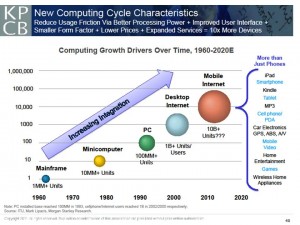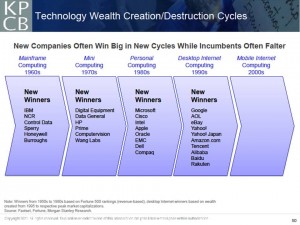 We technology market data junkies look to several thought leaders throughout the year for updates on their forecasts: one of these, for me, is Mary Meeker. Now with KPCB (who some of you know as Kleiner Perkins Caulfield & Myers, the Silicon Valley venture capital company), Meeker has surveyed the morphing field of mobile and finalized her snapshot in Top Mobile Internet Trends, along with her colleague Matt Murphy.
We technology market data junkies look to several thought leaders throughout the year for updates on their forecasts: one of these, for me, is Mary Meeker. Now with KPCB (who some of you know as Kleiner Perkins Caulfield & Myers, the Silicon Valley venture capital company), Meeker has surveyed the morphing field of mobile and finalized her snapshot in Top Mobile Internet Trends, along with her colleague Matt Murphy.
Meeker’s Top 10 (drum roll, please) are that:
- 1. Mobile platforms have reached c4itical mass
- 2. Mobile is global
- 3. Social networking is accelerating growth of mobile
- 4. Time shifting is driving mobile use
- 5. Mobile advertising involves growing pains but has huge promise
- 6. mCommerce is changing shopping behavior
- Virtual goods and in-app commerce are emerging
- Not all platforms are created equal
- Change will accelerate, with new players emerging rapidly
- Other trends to watch include ubiquitous computing, falling prices for networks and devices, faster networks (a la Moore’s Law), personalization, fun, ‘anywhere’ access, exploding apps and monetization, increasing foot traffic to physical stores, and rewarding influenced behavior in real-time for targeted markets.
One of the most insightful slides in Meeker’s deck is called “Mobile Revolutionizing Commerce – With Constant Product Improvements.” Here is a mash-up of location-based services, transparent pricing, discounted offers, and immediate gratification. Taken together, these capabilities support a consumer’s rational economic behavior as economists define the concept: more information at the point of purchase, pricing transparency and competition (via couponing, for example), GPS which localizes and personalizes offerings, and immediacy where people don’t have to wait — bolstering engagement and consumer allegiance.
Finally, as chart from Meeker’s deck rightly points out, Mobile isn’t just about phones: platforms include tablets, iPads, smartphones, Kindles, MP3 players, PDAs, car electronics like GPS systems, mobile video, home entertainment, games, and wireless home appliances.
 Health Populi’s Hot Points: This forecast has many implications for health and health care. First, mobile health isn’t only about a ‘phone.’ As Intel and others have been assessing and designing the consumer’s home as the new health hub, we can put accelerometers onto water bottles and sensors throughout a home to provide a safer, more sheltered environment for an aging person. This approach is moving mobile health into a person’s home so they can avoid admission into an institutional long-term care facility: good for the person, good for personal economics, good for Medicaid and Medicare.
Health Populi’s Hot Points: This forecast has many implications for health and health care. First, mobile health isn’t only about a ‘phone.’ As Intel and others have been assessing and designing the consumer’s home as the new health hub, we can put accelerometers onto water bottles and sensors throughout a home to provide a safer, more sheltered environment for an aging person. This approach is moving mobile health into a person’s home so they can avoid admission into an institutional long-term care facility: good for the person, good for personal economics, good for Medicaid and Medicare.
Next, look at another chart from Meeker’s forecast. Look at the ’empty’ space until Mobile Internet Computing 2000s. This is a fascinating Blue Ocean space in health and health care. We’re already witnessing new entrants coming into the health fold, most especially consumer-facing telecommunications companies, food companies, financial services and consumer electronics suppliers. With Best Buy innovating a prototype for consumer-facing health electronics products, we can only imagine who might populate this space in Meeker’s report in 2015. Many of these developments will be innovated in nations outside of the U.S. where health care payment is aligned with provision, and consumers have adopted mobile lifestyles even more quickly than people in the U.S.
Finally. mobile = social. That’s the value-add for health. The wisdom of crowds translates to wisdom of patients, wisdom of doctors, wisdom of caregivers, all on-the-move, 24×7. The more these share with each other, and across their roles, the greater the knowledge accrues and is further shared about what works in health care.
There are many other implications for health a la Meeker: which do you find most compelling? Thanks, Mary, once again for an analysis that we will all ponder and use in our work for the next year.




 Thank you FeedSpot for
Thank you FeedSpot for